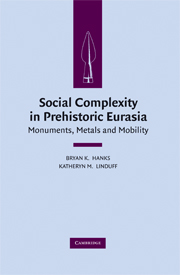Book contents
- Frontmatter
- Contents
- Contributors
- Foreword: From Myth to Method: Advances in the Archaeology of the Eurasian Steppe
- CHAPTER 1 Introduction: Reconsidering Steppe Social Complexity within World Prehistory
- PART ONE FRAMING COMPLEXITY
- PART TWO MINING, METALLURGY, AND TRADE
- PART THREE FRONTIERS AND BORDER DYNAMICS
- PART FOUR SOCIAL POWER, MONUMENTALITY, AND MOBILITY
- CHAPTER 17 Introduction
- CHAPTER 18 Re-writing Monumental Landscapes as Inner Asian Political Process
- CHAPTER 19 Socially Integrative Facilities and the Emergence of Societal Complexity on the Mongolian Steppe
- CHAPTER 20 Pre-Scythian Ceremonialism, Deer Stone Art, and Cultural Intensification in Northern Mongolia
- Index
CHAPTER 18 - Re-writing Monumental Landscapes as Inner Asian Political Process
from PART FOUR - SOCIAL POWER, MONUMENTALITY, AND MOBILITY
Published online by Cambridge University Press: 26 January 2010
- Frontmatter
- Contents
- Contributors
- Foreword: From Myth to Method: Advances in the Archaeology of the Eurasian Steppe
- CHAPTER 1 Introduction: Reconsidering Steppe Social Complexity within World Prehistory
- PART ONE FRAMING COMPLEXITY
- PART TWO MINING, METALLURGY, AND TRADE
- PART THREE FRONTIERS AND BORDER DYNAMICS
- PART FOUR SOCIAL POWER, MONUMENTALITY, AND MOBILITY
- CHAPTER 17 Introduction
- CHAPTER 18 Re-writing Monumental Landscapes as Inner Asian Political Process
- CHAPTER 19 Socially Integrative Facilities and the Emergence of Societal Complexity on the Mongolian Steppe
- CHAPTER 20 Pre-Scythian Ceremonialism, Deer Stone Art, and Cultural Intensification in Northern Mongolia
- Index
Summary
The potential for monumental structures to convert, transform, and communicate has been explored extensively in the archaeological literature (Trigger 1990; Sherratt 1990; Bradley 1998) and, most recently, with regard to social memory and its potential for re-invention through monumental re-use (Williams 2003; Van Dyke and Alcock 2003). The reuse of monumental sites in the eastern steppe region of Mongolia, Inner Mongolia, southern Siberia, Xinjiang, and eastern Kazakhstan (referred to here as Inner Asia), very likely dates back more than 3,000 years and persists in certain forms even today. While creating spatial and stylistic associations with former monuments of grandeur is a common method for bolstering political legitimacy in complex societies, especially in states and empires (Sinopoli 2003), understanding the role such practices play in the formation of initial socio-political complexity is a more subtle task.
In this chapter, we examine the remains of monumental activities in a northern Mongolian river valley over a period of 1,000 years during the first and second millennia bce. Our study focuses on the question of what stone mounds and prominent burials might tell us about the character of political change in this local area and, by extension, across the eastern steppe. In the long process of building lineage-based institutions of inequality, local valley groups utilized monuments from their own past while simultaneously creating new monumental forms and associated activities.
- Type
- Chapter
- Information
- Social Complexity in Prehistoric EurasiaMonuments, Metals and Mobility, pp. 330 - 357Publisher: Cambridge University PressPrint publication year: 2009
- 20
- Cited by

